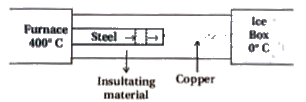Complete Solutions to Section - B of chapter THERMAL PROPERTIES OF MATTER of Class 11 book with complete answers and questions
| Class 11 | PHYSICS |
| Chapter | THERMAL PROPERTIES OF MATTER |
| KUMAR PRAKASHAN | Section - B |
| Number Of Questions | 10 |
| Academic Year | 2023-24 |
Show that the coefficient of area expansions, `(DeltaA//A)//DeltaT`, of a rectangular sheet of the solid is twice its linear expansively, `alpha_(l).(alpha_(l)=10^(-5)K^(-1))`
View SolutionA blacksmith fixes iron ring on the rim of the wooden wheel of a bullock cart. The diameter of the rim and the iron ring are 5.243m and 5.231 m respectively at `27" "^(@)C`. To what temperature should the ring be heated so as to fit the rim of the wheel ? `(alpha_(1)=1.20xx10^(-5)K^(-1))`
View SolutionA blacksmith fixes iron ring on the rim of the wooden wheel of a bullock cart. The diameter of the rim and the iron ring are 5.243m and 5.231 m respectively at `27" "^(@)C`. To what temperature should the ring be heated so as to fit the rim of the wheel ? `(alpha_(1)=1.20xx10^(-5)K^(-1))`
View SolutionA sphere of aluminium of 0.047 kg placed for sufficient time in a vessel containing boiling water, so that sphere is at `100" "^(@)C`. It is then immediately transferred to 0.14 kg copper calorimeter containing 0.25 kg of water at `20" "^(@)C`. The temperature of water rises and attains a steady state at `23" "^(@)C`. Calculate the specific heat capacity of aluminium.
View SolutionWhen 0.15 kg of ice of `0" "^(@)C` mixed with 0.30 kg of water at `50" "^(@)C` in a container, the resulting temperature is `7.6" "^(@)C`. Calculate the heat of fusion of ice. `" "(S_("water")=4186" J kg"^(-1)K^(-1))`
View Solution(a) How much heat should be provided to ice of 720 g mass, lying at -`10^@C` to melt it to water at `0^@C` ? (b) How much heat should be provided to water at `0^@C` to increase its temperature to `100^@C` ?(c) How much heat should be given to water at `100^@C` to transform it completely into water ?
(d) Totally, how much heat should be given to ice of 720 g at `-10^@C` to convert it completely into vapour ? (C"ice"=2220 "J kg"^(-1) K^(-1), C"water"=4190 "J kg"^(-1) K^(-1) , LF=333 "kJ"/"kg", LV=2256 "kJ"/"kg"`)
View SolutionWhat is the temperature of the steel - copper junction in the steady state of the system shown in Fig. Length of the steel rod = 15.0 cm, length of the copper rod = 10.0 cm, temperature of the furnace `=400" "^(@)C`, temperature of the other end `=0" "^(@)C`. The area of cross section of the steel rod is twice that of the copper rod.
(Thermal conductivity of steel `=50.2" J s"^(-1)m^(-1)K^(-1),` and of copper `=385" J s"^(-1)m-1" "K^(-1)`).

View SolutionWhat is the temperature of the aluminium junction in the steady state of the system shown in Fig. Length of the load `=15.0` cm, length of the aluminium rod `=10.0` cm temperature of the furnace = `400" "^(@)C`, temperature of the other end `=0" "^(@)C`. The area of cross section of the lead rod is twice that of the aluminium rod.
(Thermal conductivity of steel `=34.9" J s"^(-1)m^(-1)K^(-1),` and copper `=205" J s"^(-1)m-1" "K^(-1)`)

View Solution
In above diagram, a combined rod is formed by connecting two rods of length `l_(1)` and `l_(2)` respectively and thermal conductivity `k_(1)` and `k_(2)` respectively. Temperature of ends of rods are `T_(1)` and `T_(2)` constant, then find the temperature of their contact surface ?
View SolutionA pan filled with hot food cools from `50^(@)C` to `48^(@)C` in 5 s when the room temperature is at `30^(@)C`. How long will it take to cool from `40^(@)C` to `39^(@)C` ?
View Solution
Section - B questions and complete solutions for chapter THERMAL PROPERTIES OF MATTER of KUMAR PRAKASHAN KENDRA PHYSICS (GUJRATI ENGLISH) of Class 11
All Exercises from KUMAR PRAKASHAN Class 11 PHYSICS THERMAL PROPERTIES OF MATTER
- Information : Higher Order Thinking Skills (HOTS)
- Question Paper (Section - A) Answer following in one sentence : (Word limit of answer is 10) (Each question carries 1 mark)
- Question Paper (Section - B) Answer the following question in short : (Word limit of answer is 10) (Each carry 2 mark)
- Question Paper (Section - C) Do as directed : (Word limit of answer is 10) (Each carry 3 mark)
- Question Paper (Section - D) (Answer following in brief :) Each carry 4 marks
- Section - A Questions-Answer
- Section - B
- Section - B (Numericals) Numerical From Textual Exercise
- Section - B (Numericals) Numerical From Textual Exercise (Answer the following : )
- Section - B (Numericals) Numerical From Textual Illustration
- Section - B Numerical From .DARPAN. Based On Textbook
- Section - C Objective Questions (VSQs)
- Section - C Objective Questions (VSQs) Are the following Statements True or False ?
- Section - C Objective Questions (VSQs) Assertion and Reason Type Questions
- Section - C Objective Questions (VSQs) Fill in the Blank
- Section - C Objective Questions (VSQs) Match Type Questions
- Section - D NCERT Exemplar Solution (Long Answer Type Questions )
- Section - D NCERT Exemplar Solution (Multiple Choice Questions MCQs)
- Section - D NCERT Exemplar Solution (Multiple Choice Questions MCQs) More than one options
- Section - D NCERT Exemplar Solution (Short Answer Type Questions )
- Section - D NCERT Exemplar Solution (Very Short Answer Type Questions )
- Section - E Multiple Choice Questions (MCQs)
- Section - F Question from Module (Sample questions for preparation of competitive exams)
- Try Yourself (VSQs)